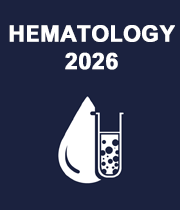Abstract:
Hereditary red blood cell (RBC) membranopathies are characterized by mutations in genes encoding skeletal/lipid bilayer proteins that alter the membrane complex structure. Hereditary spherocytosis (HS) is the most common inherited RBC membranopathy, leading to hereditary hemolytic anemia with a worldwide distribution and an estimated prevalence in Europe of about 1:2,000 individuals. The recent availability of targeted next generation sequencing (t-NGS) and its combination with RBC deformability measured with a laser-assisted optical rotational ektacytometer (LoRRca) has demonstrated to be the most powerful contribution to lower the percentage of hereditary hemolytic anemia undiagnosed cases. The osmoscan module of LoRRca provides three rheological parameters that reflect the maximal deformability (EImax), osmotic fragility (Omin), and hydration state (Ohyper) of RBCs and contribute to a better understanding of the contribution RBC rheology to the severity of anemia. In order to know the kind and frequency of RBC membrane mutations in our geographical area (Catalonia) and to better understand their pathophysiology, a cohort of 161 unrelated non-transfusion-dependent (NTD) patients with hereditary hemolytic anemia (HHA) have been studied by combining t-NGS and LoRRca. Hemoglobinopathies and erythroenzymopathies were discarded by standard laboratory procedures. From these 161 patients, 93 were phenotypically suspected to be a RBC membrane defect (HS in 73 , hereditary elliptocytosis in 15, and hereditary xerocytosis in 5) and 68 exhibited an inconclusive phenotype. Using tNGS, the mutation was identified in 84 out of 93 patients (90%) and in 51 out of 68 patients (75%). A total of 26 out of 161 patients (16%) remained undiagnosed. In all the cases, the osmoscan module of LoRRca contributed to a better understanding of the contribution of RBC rheology to the severity of anemia
Audience takeaway:
Our research aims to provide the following advantages to the audience:
1.Can be used by other faculty to expand their research or teaching
2.Will provide a practical solution for simplify questions and/or for make job more efficient
3.Will it improve the accuracy of a design or provide new information
Biography:
Joan Lluís Vives Corrons is Professor Emeritus of the University of Barcelona , and honorary researcher assigned to the Josep Carreras Institute for Leukaemia Research (IJC). He has accumulated a long trajectory in the diagnosis of rare anemias, and the study of the molecular bases of red blood cell (RBC) enzymopathies, membranopathies and hemoglobinopathies.
During his more than 30 years of activity at the Hospital Clinic of Barcelona (HCB) as Head of the Haematology Laboratory Department (1976-1997) and of the Red Blood Cell Pathology Unit (1998-2016) , his research activity has been focused on the physiopathological study of anemia in general, but especially in the molecular and genetic mechanisms of congenital anemias due to RBC defects. He has been IP of more than 35 research projects , mainly on enzymopathies , such as glucose 6 phosphate dehydrogenase (G6PD) and pyruvate kinase (PK) , sickle-cell disease (SCD), and hereditary membranopathies.
In 2002, the European Commission (EC) approved the co-financing of the European Network for Rare and Congenital Anaemias (ENERCA) within its Public Health System (SANCO-Public Health) with the aim to create a pan-European network for diagnosis, treatment and epidemiology (registry) of rare anemias (RA). This project was coordinated by Prof. Vives Corrons.
In 2009, the Red Cell Pathology Unit received the financial support of the TV3 Marato Foundation for "rare diseases" (2009- Ref. 101730). This allowed the creation of the Catalan Network for Diagnosis and Monitoring of patients with severe hemoglobinopathies (CATGLOBIN) with the collaboration of professionals from 15 hospitals in Catalonia. As a consequence of this multicentre activity, cooperation was established between the Marato Research Group and the Catalan Government (Generalitat de Catalunya) to undertake a Pilot Newborn Screening Programe for SCD in Catalonia. As the consequence of the successful results obtained with this Pilot Project, the Catalan Government decided, in 2015, to incorporate the newborn screening programme for SCD into its official Neonatal Screening Program (CN) . This has been the most important outcome of this Marato Project.
In 2013, the coordination of the FP7 European Project CoMMitMent (HEALTH-F5-2013-602121) allowed the identification of new genes and therapies related to RA through the development of a team composed of different experts that investigate alterations in erythrocyte ion homeostasis (channelopathies) and their rheological behaviour (microfluidics).
In 2016, after the European Commission (EC) Call for European Reference Networks (ERN) on Rare Diseases (RD), ENERCA appointed for the ERN for Rare Haematological Diseases that, in addition to the rare anemias, included all the blood rare diseases, both oncological and non-oncological. This ERN Project was approved by the EC under the name EuroBloodNet.
In 2017, after Prof. Vives Corrons, retirement, the research staff of the HCB Red Cell Pathology Unit moved to the Josep Carreras Institute for Leukaemia Research (IJC) where the research activity in rare anemias remains active.



